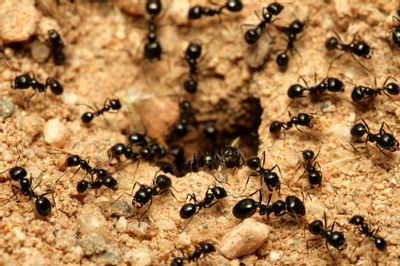
They love to nest in wood and will find your house a great place to “set up shop”. Although they don’t actually eat wood, they like to live in wood. They chew tunnels and nests in wood which causes major structural damage over time.
Carpenter ants don’t sting, but they have strong mandibles and their bite can be ferocious. We had a client who went out to split firewood dressed in only his pajamas and learned the hard way that carpenter ants do bite. Our advice is to wear protective clothing whilst chopping wood.
Carpenter ants will leave telltale signs of grainy sawdust and chewed-up pieces of dead ants in the wake of their tunnels. If you find chunky pieces of sawdust around your house, either inside or out, call Koby Pest Control today!
This ant will invade a house, nesting and tunneling through softer wood inside the structure. It is common to see this ant carving out a nest in rigid polystyrene foam or fiberglass insulation. One of the most common areas for this ant to nest in is open beam ceilings. The ant will harbor in the hard foam insulation between the tongue, groove wood, and the roof structure.
As the colony grows, they tunnel through the nesting material and kick out the excess foam through cracks in the ceiling. The foam kicked out by the pine tree ant will be very fine in consistency. Any areas in the house that have this type of insulation are susceptible to pine tree ants.
Pine tree ants will also nest in fiberglass insulation. We have gone into an attic and found these ants living in and chewing on fiberglass insulation. Anyplace in a house that is protected and a viable place to nest with either insulation or softwood can be attacked by pine tree ants.
Most likely introduced into the state by sheep shipments from Argentina, these ants have taken over and produced “super colonies” that stretch from Oregon to Mexico. Your backyard could have several satellite colonies, each one numbering in the hundreds of thousands, and all of them are related to each other.
Argentine ants will usually stay outside, until they find a food source inside your kitchen or pantry. Then they may enter by the thousands. Environmental stress such as hot weather or extreme cold and rain, can drive these ants into your house.
Another interesting aspect of the Argentine ant is their relationship with plant insects such as aphids and scale. The ants harvest the honeydew produced by these insects and will actually carry aphids from branch to branch to harvest the honeydew. One way to lessen an Argentine ant population in your garden is to eliminate aphids and scale. Use of non-repellant pesticides and bait will control these pesky critters.
Velvety Tree ants do not have a stinger but have strong mandibles and will bite if they are agitated. Many tree trimmers have found this out the hard way.
Treatment of ant nests and trails usually leads to control.
Many of the products used for the control of ants use the ant’s socialization skills to work against them. Ants communicate and groom each other through touching. Many of the baits and other products used in ant control use this, 'transference effect" and it is passed from ant to ant to eliminate large colonies. Odorous house ants don't seem to be as social so this "transference effect' is reduced.
It is best to try and treat these ants early in the season before their nests get large.
When Pharaoh ant colonies come under stress like from a repellent pesticide application, the colony will bud and any ants that survive will form several new colonies, making the problem worse. Baiting and using non-repellent pesticides work best and can eradicate these ants in a few days.